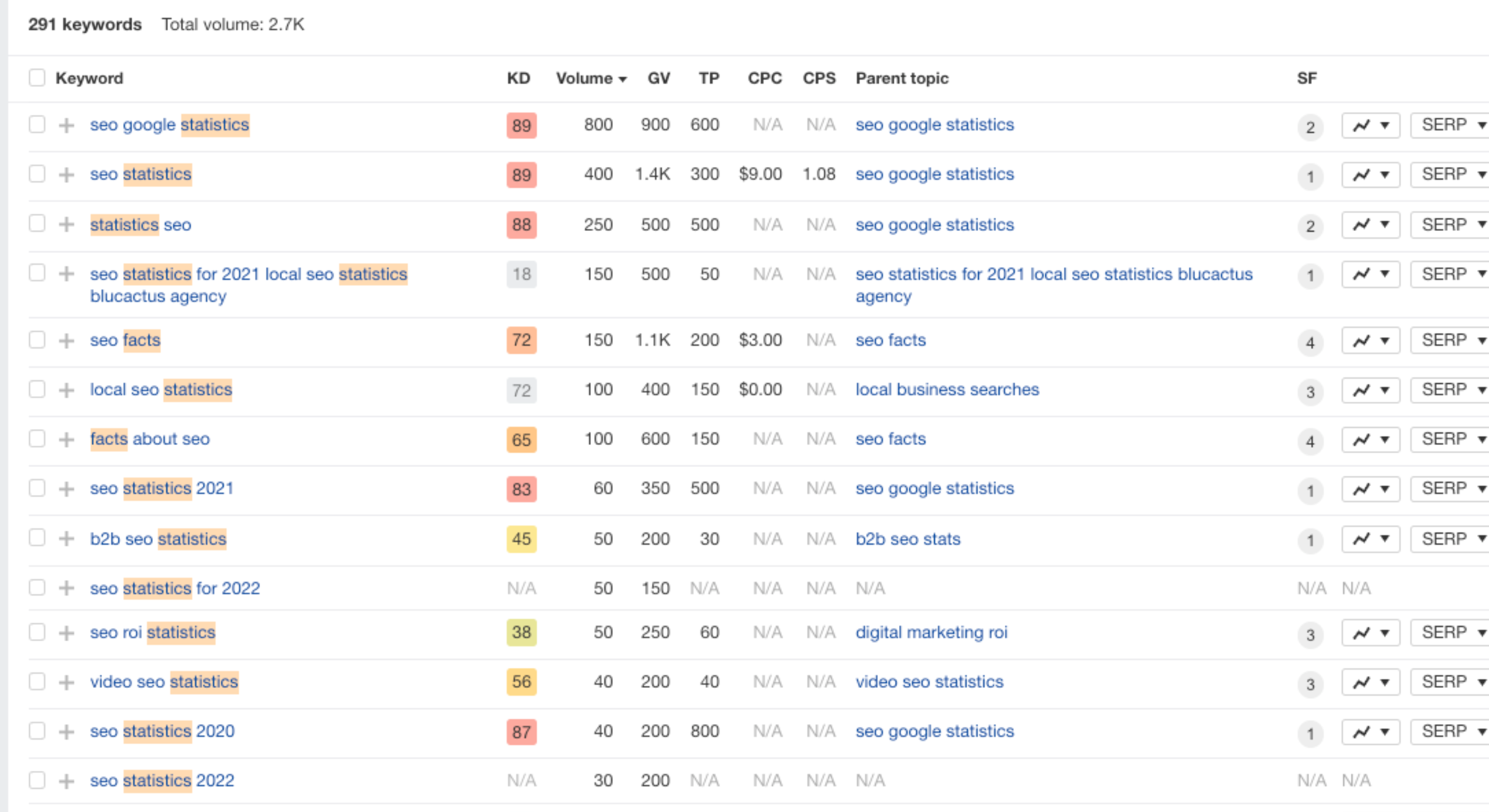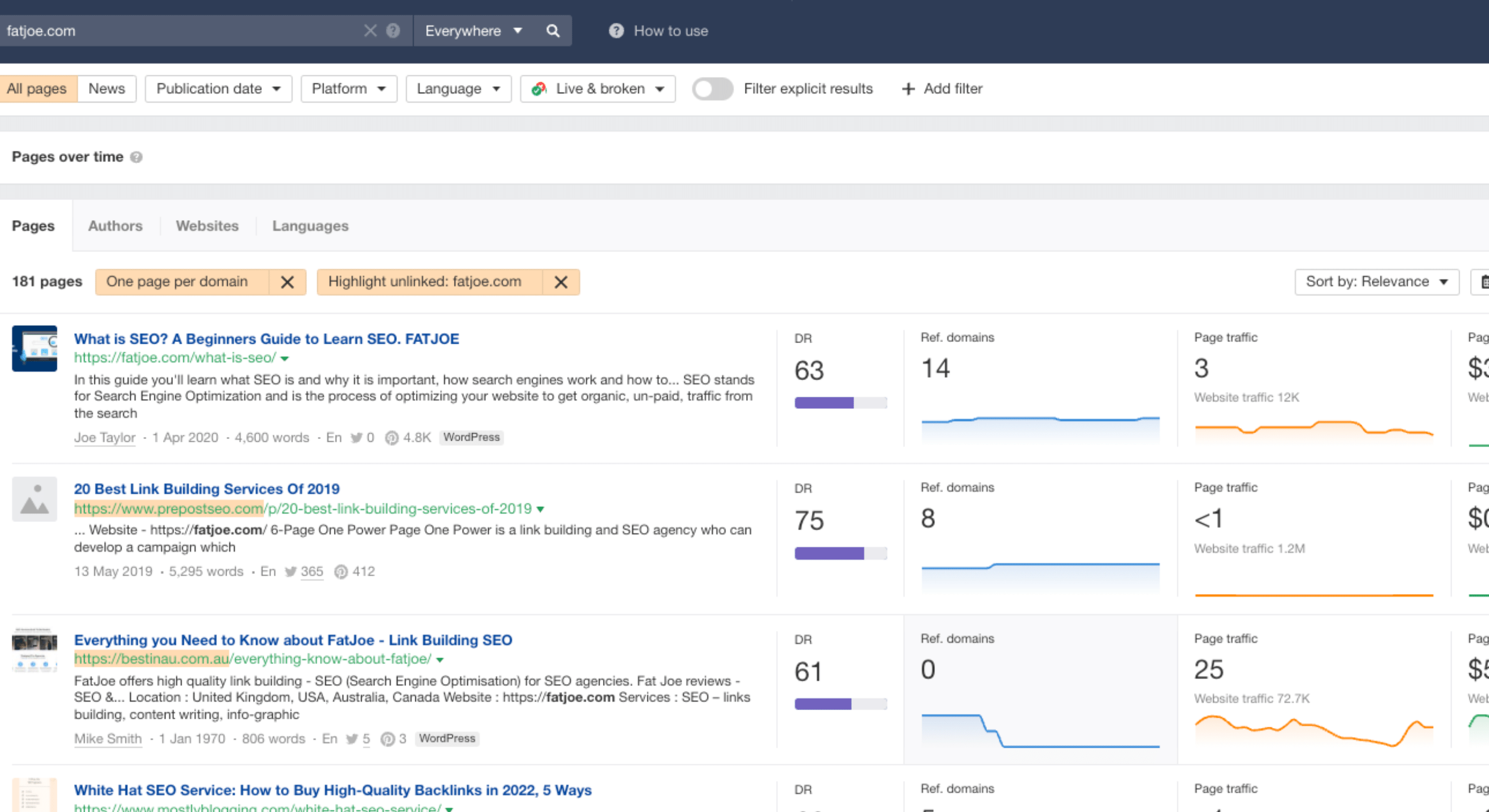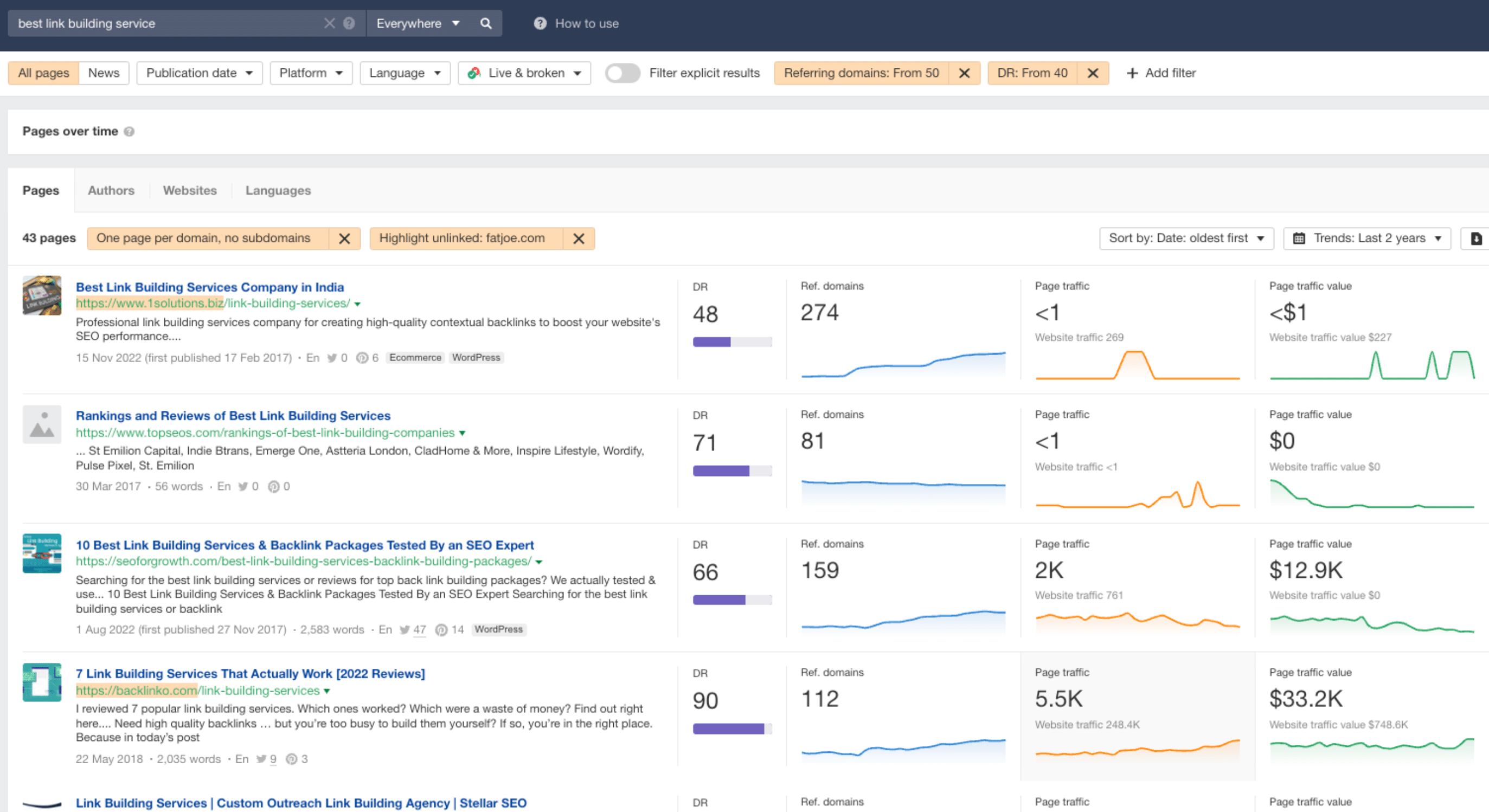Link Building for Ecommerce Websites: A Comprehensive Guide
Daniel Trick
Nov 29, 2022
11 min read
Just like any other online brand, ecommerce websites need to invest in search engine optimization (SEO). Without it, they’re dead in the water.
Link building is a critical part of this process. But getting to grips with it is challenging. For ecommerce businesses, it can feel like an enigma. You understand it in principle, but how do you actually do it in practice?
That’s why you need a comprehensive guide to SEO for ecommerce websites like this one along with this guide to link building for e-commerce websites. Here, we briefly explain what link building is, how to build links to your site, and some of the strategies you can use to get more links.
Ultimately, we hope you’ll see that SEO for ecommerce websites isn’t as complicated as it first seems.
What Is Link Building And Why Is It Important For SEO for Ecommerce Websites?
Link building is the process of constructing links from other web pages and domains to your own.
Google (and other search engines) view links as a vote of confidence in your URLs. The more you have, the more valuable your content is, and the higher you will rise in the ranks.
The value of link building for online stores depends on three factors: trust, relevancy and authority.

Why Trust?
Trust measures how much Google believes linking domains are legitimate. It quantifies the degree to which they provide value to users.
Why Relevancy?
Relevancy measures the degree to which linking domains relate to your site. Google likes relevant links because they are more helpful to users.
For instance, if your store sells climbing gear, then links from climbing magazines are more relevant to users than links from the local pizza shop. Similarly, if you sell boots, Google will weigh links from fashion or clothing review sites more highly than drug stores.
Why Authority?
Lastly, Google considers authority when determining the value of a link.
Page authority is the weight Google ascribes to the particular page linking to you. Domain authority considers the entire domain (e.g. Forbes.com as a whole, rather than a single news article on the site that mentions you). And link authority is about the quality of the link from pages A to B.
Many external companies try to quantify how strong a website or page is via their own metrics. You might for example see DA (Domain Authority) or DR (Domain Rating).
While these aren’t official Google metrics these tools have gotten pretty good at determining the relative strength of different sites. When targeting sites for links, you want this number to be as high as possible.
After building links successfully, your site will begin to move up in search engine page results (SERPs). The higher it goes, the more organic (non-paid) conversion opportunities you will get. Happy days!
How To Do SEO For Ecommerce Websites: Some Basic Concepts
Getting SEO for ecommerce sites right requires adopting the correct approaches.
Here we detail all the link building basics for SEO for ecommerce sales and how to avoid common mistakes.
1. Choose A Link Origin And Target
The link origin is the third-party page you place the link on. The target is the specific page on your site the link follows through to. This page could be your home page, a product page, or a blog.
For maximum effect, you want both the origin and target pages to share the same topic and complement your sales funnel.
For instance, suppose your ecommerce store sells garden awnings. Getting a link from Housebeautiful.com would make a lot of sense in this context because its users are probably interested in your products. By contrast, users on Gamespot.com probably aren’t.
2. Pick Your Anchor Text
Next, you’ll want to pick your anchor text – the text that you link.
For instance, this is an anchor text that leads to our homepage. (Click it if you want!)
You have quite a bit of flexibility when it comes to anchors, but for the purposes of SEO for retail websites, you’ll want to use a variety. (Using the same anchors repeatedly can raise eyebrows at Google).
Here’s a list of the different types of anchors you’ll want to include:
- Branded – anchors that include your brand name in the link text. (e.g. if your brand name is Amazon, you’d use “Amazon” as the anchor text).
- Exact match – anchors that match the keywords you target on your pages. (e.g. if you have a product category page for Venetian blinds, the anchor would be “Venetian blinds”.)
- Partial match – anchors that only partially reflect the destination page’s primary keyword. (e.g. the anchor could be just “Venetians” for a Venetian blind product category page).
- Call to action (CTA) – an anchor that tries to get a user to do something. (e.g. “click here” or “buy Venetians today”).
3. Keep It Natural
The best SEO for ecommerce sites uses all of these anchor methods. They are more useful for users and Google and its army of bots.
Don’t fall into the trap of linking with the same anchor texts dozens of times. That’s going to look artificial to Google. Rather, mix things up a bit by changing your anchor texts and target pages.
Also, slowly build links over time. Don’t go from zero to a thousand overnight. That’ll look artificial, too.
If you want to find out what’s normal for your industry, use competitor analysis tools to spy on top-performing rivals. See where they are getting their links, which anchor texts they are using, and how long it took them to build their backlink profile.
4. Prioritize Follow Links
Follow links tell Google’s website crawlers to follow links on sites, hence the name. Therefore, if you want to get found, they are helpful. By contrast, nofollow links stop search engine bots in their tracks.
High-quality SEO for ecommerce stores seeks to build as many follow links as possible. But even if third-party sites link to you with the nofollow attribute, it isn’t the end of the world. Even these contribute to your position in SERPs. Many of the world’s top domains, such as Quora, YouTube, and Wikipedia attach the “rel=nofollow” tag to all their external links, so it won’t do you any harm.
Tactics For Effective Link Building
SEO for online store owners requires adopting the right tactics and deploying them effectively. There are two fundamental ways to get links:
- Create quality content that encourages organic links
- Build active relationships with third-party websites or agencies to generate links back to yours
1. Find Bloggers Willing To Feature Your Products In Reviews
Getting backlinks as an e-commerce website is notoriously challenging. However, asking bloggers to feature your products in their reviews is a strategy that works.
Here’s what you need to do:
- List all the product categories you sell
- Search for related review articles on Google and find any that don’t list you
- Approach host sites and ask them if they wouldn’t mind reviewing a sample product
- Wait a few weeks and see if they add your product to their listicles with a link. If they don’t, follow up
A couple of rules. First, make sure your products are good. Bloggers don’t want to recommend junk to their audiences.
Second, don’t exchange products for backlinks. Google views tactics like that as “schemes” and you could hurt your SEO.
Because of this, you need to be careful with your pitch. Say something like:
Hi. We’ve just read your excellent article on the best [insert your product] but we noticed that you didn’t include us.
We’d like to send a sample of our product so you can review it. Let me know if that sounds like a good idea.
Best wishes
Usually, when you do that, the blogger will be more than happy to review the product and create a link to your product pages.
2. Publish Pages That Curate Statistics
Bloggers, journalists and even students are constantly on the lookout for easy-to-find statistics. They demonstrate in-depth research. Just like this post about SEO statistics from yours truly.
Today, you can find a plethora of statistics pages for virtually any topic. But why are they good for SEO?
Simple: statistics attract enormous numbers of backlinks. Everyone wants to cite their sources.
So what do you need to do for this tactic? Here’s a rundown:

- Use keyword explorer tools (such as SEMrush or Ahrefs) to find the type of statistics people search for related to your products.
- Search the results for promising statistics you could research. (Hint: the ones with the most backlinks are the best to target).
- Create your own statistics page
The best statistics pages are those that use your own figures. However, even if you can’t commission a survey or study, citing other websites can still boost SEO tremendously. If people can find statistics on your site that aren’t on others, they’ll link to you.
3. Pitch Stockist Or Where To Buy Pages
Most e-commerce firms are resellers. That is, they sell third-party manufacturer products.
The following strategy involves getting listed on manufacturers’ “where to buy” or “official stockists” pages. Links from well-known brands often provide significant domain authority and are relevant to your site, two factors we discussed earlier.
Here’s what you need to do to make this tactic work:
- List of all the manufacturers whose products you sell
- Search online to see if they have pages on their websites listing “official stockists” or some variation on that term. (Most vendors include these pages because they want to direct their customers to reputable stores).
- Send an email telling the manufacturer that you stock their products
You don’t need to do anything complicated for this one. A simple email will suffice. Remember, the vendor also benefits when they list and link to your store.
4. Find Unlinked Brand Mentions And Get Third-Party Sites To Link To You
This tactic isn’t particularly effective if you’re just starting off, but it can be highly impactful if you’re already quite well-established.
The basic idea is to get sites that name your brand or products to create new links to your site, using mentions as anchors.
Finding unlinked mentions manually would be a nightmare. But, fortunately, you can speed up the process using helpful tools, such as Ahrefs Content Explorer.

All you need to do is search for your brand name or relevant keywords and then click “Highlight unlinked” in the dropdown menu to the side of the “Pages” search tab. Ahrefs will then spit back all the websites that fail to link along with their mention. You can then email them, asking them to link to you.
If you get a lot of search hits, filter by domain authority. Send emails to the most valuable sites first and then work your way down the list. Make your pitch friendly and address people personally if you can. That’s more likely to get a response.
5. Ask To Update Existing Review Posts or Buying Guides
Updating existing guest posts works even better than creating a new one from scratch. That’s because you can pick and choose guest posts that already have backlinks, improving the strength of any new link you add.
If the post is reviewing competitors, it’d be a nice addition to add a link to you too.

Here’s what you need to do for this tactic to work:
- Fire up a tool like Ahrefs Content Explorer
- Find posts that review a certain category of products. For example, Best Microwaves, Best Stand Up Desks, Best Link Building Service. You get the picture.
- Refine your search to look for outdated pages that are at least two years old. (Site owners probably don’t want you updating pages that are just a couple of months old but they will consider your request if they are years old).
- Refine your search to yield domains with a rating of 40 or more. This way, you can eliminate sites with low authority from your search.
- Set the referring domains filter to 50 (or higher if you want) to find pages with backlinks.
- Highlight unlinked, and set your domain.
Look for pages that are out of date and have falling but high traffic. You want sites that have a lot of traffic but are on the cusp of losing their mojo because they are out of date. Prioritize sites with high domain authority as that will give you more SEO juice.
Once you have a shortlist of websites, write their site owners an email. Here’s the sort of thing you want to say:
Hi [site owner]
Just noticed that your blog on [topic relating to your brand] is out of date. We can help improve the post because, as an online retailer, we’re right at the forefront of the [topic]. All it needs is a quick refresh and, hopefully, you’ll get more traffic as a result.
Good idea? Let us know.
Best wishes
6. Write Great Articles That Are Linkworthy!
The better your articles are, the more websites will link to you, increasing both page and domain authority…
To make your blog post effective, do the following:
- Include original material users cannot find anywhere else
- Offer discounts or incentives to readers
- Add statistics and interesting infographics
- Make it shareable
- Make it snackable (by breaking up paragraphs, and including plenty of tables and bullet points)
- Create enough content to be genuinely useful (think, more than 1,000 words)
- Include outbound links to sites you are targeting for link building to get their attention
This will requiring hiring a great writer, or using a blog writing service that meets your brand guidelines.
7. Reach Out Via Email To Partners
SEO for online retailers also involves reaching out to partners who cover topics that are relevant to you. For instance, if you have a supplier that sends you stock, ask them if they would be willing to host an article or webpage with a link to your products.
8. Don’t Sleep On Your On-Page SEO
On-page SEO for ecommerce website owners is critical. Sites that contain the right headings and keywords maximize the effectiveness of your link building.
Landing pages are a good example. Make sure that they contain relevant intent-focused keywords targeting your audience. For example, if you sell cakes via your store, include keywords such as “cake supplier near me,” “birthday cake delivery” and “custom-made cakes for weddings.”
9. Add Links On Business Directories
Today, there are dozens of business directories you can use to build links. However, they aren’t always relevant for ecommerce websites. If you choose to use directories, pick carefully. The most generic are:
- Bing Places
- Google Business Profile
- BBB Directory
- CitySearch
10. Donate
You shouldn’t directly pay organizations to link to you, but it can’t help to donate. This way, they are far more likely to link back to your site.
For retailers, you might want to sponsor good causes. Charities you support may post links to you about pages and blogs for their audiences to read more.
Bonus Tip: Outsource Your Link Building
Lastly, you might want to consider using link building services for all or a part of your campaign. These incorporate practically all of the tactics and strategies outlined in this post.
It’s all turn-key. You pay a service fee in exchange for access to a network of high domain-authority websites and blogs. Agency writers then create organic content for these sites with links back to yours. You can improve SEO for your ecommerce site with online courses, but it’s much easier to go to a professional.
Looking for more strategies to get backlinks? Check out our other great post!
Conclusion
So what have we learned? Essentially, ecommerce link building is all about getting your store noticed online. Effective links and anchors are relevant, trustworthy, and originate from sites with high domain authority.
Just be warned: effective link building takes time. Expect to wait between three and six months before seeing results.
Become a Pro at SEO
Join 65,000 others and learn the secrets to SEO success with our weekly blog posts.
